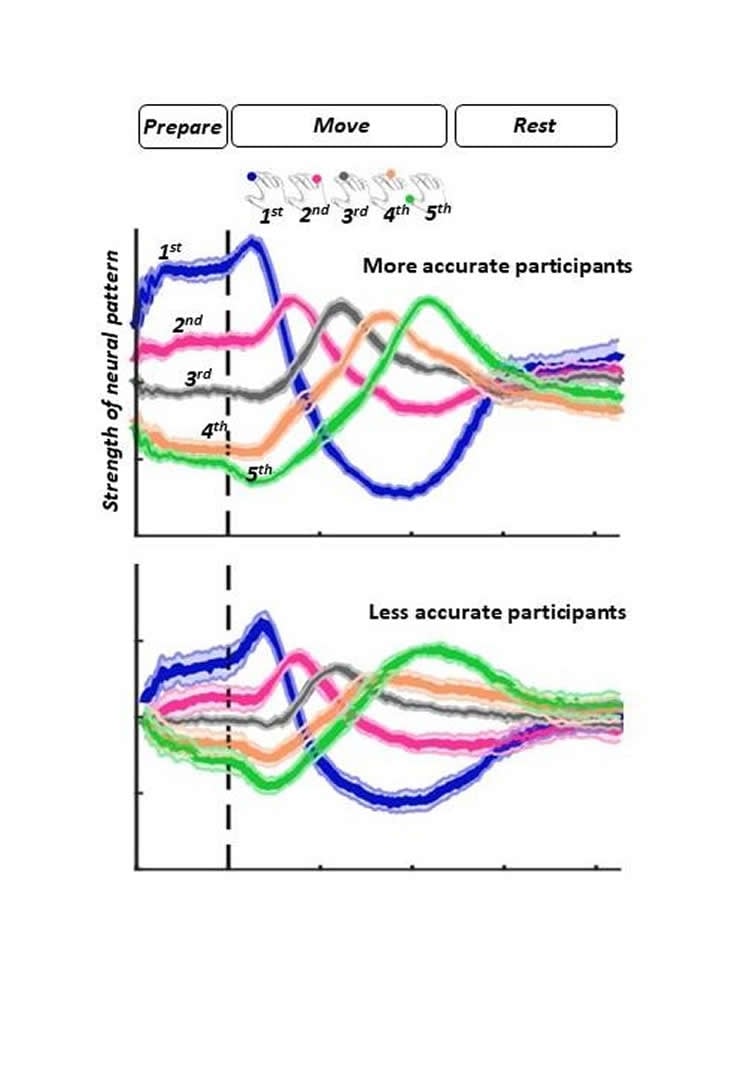Summary: Researchers have identified the neural processes that occur milliseconds before we execute a series of skilled movements.
Source: Bangor University.
Neuroscientists at Bangor University, and University College London (UCL) have for the first time, identified the processes which occur in our brains milliseconds before we undertake a series of movements, crucial for speech, handwriting, sports or playing a musical instrument. They have done so by measuring tiny magnetic fields outside the participants’ head and identifying unique patterns making up each sequence before it is executed. They identified differences between neural patterns which lead to a more skilled as opposed to a more error-prone execution.
The research, funded by the Wellcome Trust, is published in Neuron. Following further research, this new information could lead to the development of interventions which would assist with rehabilitation post-stroke or improve life for people living with stutter, dyspraxia or other similar conditions.
Lead author Dr Katja Kornysheva, of Bangor University’s School of Psychology explained the significance of the findings:
“Using a non-invasive technique which measures ongoing brain activity on a millisecond-by-millisecond basis, we were able to track brain activity as participants prepared and then moved their fingers from memory. This revealed that the brain prepares for complex actions in the milliseconds beforehand by ‘stacking’ the actions to be taken, in the correct order.”
“Reviewing the brain impulses, we could see that when participants were producing the sequences correctly and accurately, with no errors, each activity was spaced and ordered in advance of being executed. However, when mistakes occurred, the ‘queuing’ of actions was visibly less well-defined as separate and distinct actions. It appears that the more closely bunched and less-defined ‘queuing’ was, the more participants committed errors in sequence production and timing.
Co- researcher and author, Prof Neil Burgess, of UCL’s Inst of Cognitive Neuroscience commented:

“To our surprise we also found that this preparatory pattern is primarily reflecting a template for position (1st, 2nd, 3rd and so on) which can be reused across sequences – like cabinet drawers into which one can put different objects. This is a way for the brain to be efficient and flexible, by providing a blueprint for new sequences and staying organized.”
“Unfortunately, disorders of sequence control and fluency can severely disrupt everyday life – with no treatment being predictively effective. Eventually, this research could lead to the development of ‘as it happens’ decoders which would provide instant feed-back to the user. This could help to ‘train’ their brains to create the correct preparation state and overcome difficulties such as a stutter or dyspraxia. We hope that the new understanding could also lead to the development of improved brain computer interfaces, used by people who are ‘locked- in# or have whole body paralysis.”
Funding: Wellcome Trust Principle Research Fellowship, Sir Henry Wellcome Fellowship funded this study.
Source: Elinor Elis-Williams – Bangor University
Publisher: Organized by NeuroscienceNews.com.
Image Source: NeuroscienceNews.com image is credited to Katja Kornysheva & authors.
Original Research: Open access research for “Neural Competitive Queuing of Ordinal Structure Underlies Skilled Sequential Action” by Katja Kornysheva, Daniel Bush, Sofie S. Meyer, Anna Sadnicka, Gareth Barnes, and Neil Burgess in Neuron. Published January 2019.
doi:10.1016/j.neuron.2019.01.018
[cbtabs][cbtab title=”MLA”]Bangor University”How the Brain Prepares For Action.” NeuroscienceNews. NeuroscienceNews, 7 February 2019.
<https://neurosciencenews.com/brain-action-preparation-10710/>.[/cbtab][cbtab title=”APA”]Bangor University(2019, February 7). How the Brain Prepares For Action. NeuroscienceNews. Retrieved February 7, 2019 from https://neurosciencenews.com/brain-action-preparation-10710/[/cbtab][cbtab title=”Chicago”]Bangor University”How the Brain Prepares For Action.” https://neurosciencenews.com/brain-action-preparation-10710/ (accessed February 7, 2019).[/cbtab][/cbtabs]
Abstract
Neural Competitive Queuing of Ordinal Structure Underlies Skilled Sequential Action
Fluent retrieval and execution of movement sequences is essential for daily activities, but the neural mechanisms underlying sequence planning remain elusive. Here participants learned finger press sequences with different orders and timings and reproduced them in a magneto-encephalography (MEG) scanner. We classified the MEG patterns for each press in the sequence and examined pattern dynamics during preparation and production. Our results demonstrate the “competitive queuing” (CQ) of upcoming action representations, extending previous computational and non-human primate recording studies to non-invasive measures in humans. In addition, we show that CQ reflects an ordinal template that generalizes across specific motor actions at each position. Finally, we demonstrate that CQ predicts participants’ production accuracy and originates from parahippocampal and cerebellar sources. These results suggest that the brain learns and controls multiple sequences by flexibly combining representations of specific actions and interval timing with high-level, parallel representations of sequence position.







